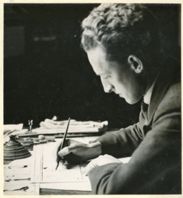
The Website of William St John Glenn (1904 - 1974)

WILLIAM ST. JOHN GLENN R.U.A (1904-1974).
As a first step to gaining experience, he entered the Artists’ Department in a small publishing house, Graham & Heslip Ltd and for over five years illustrated countless booklets, did figure sketches in black and white and colour, and show- card and advertisement designing.
Towards
the end of 1926 he started free-lancing
cartoons for newspapers and had drawings published in the Belfast
Telegraph
and the Irish Daily Telegraph, Judge, The Passing Show, London
Opinion,
Dublin Opinion, Radio Times and Scout.
While with the Belfast Telegraph he became a
Member of the
Institute of Journalists, and wrote his own
column on
topical subjects. He also had the opportunity to be involved in
experimental
press photography and was responsible for doing the touch up of
photographs,
particularly official persons and dignitaries.
There is no doubt that Dorothea was a very attractive woman and
remained an
inspiration to William St.J. Glenn throughout his life as an artist. In
1929,
Pears Soap organized a
competition to find the "Most Charming Woman of Ulster" and Dorothea
who received her prize in London won it. Another artist who found
Dorothea
attractive enough to ask to paint her was Frank Mc Kelvey R.H.A.
He painted her life size portrait in water colour. Dorothea was
a cousin
of the famous Brontes. Her great-great grandfather was William Bronte,
the
Reverend Patrick Bronte's brother. William
and Dorothea married on June 3rd 1930 at Belfast Cathedral and the
crowds of
spectators in the photos made this look very like a film star wedding. The
Ulster
Academy of Art. In
1931, he was elected member of the Ulster Academy of Art and in
1936
elected full Academician and Vice-President.
In 1931 the first exhibition of the Ulster Academy of Art was opened in
the Municipal Art Gallery, Belfast.Glenn exhibited two watercolours and over the coming five years, he exhibited
watercolours, oil paintings, an occasional black and white sketch and
even,
unusually, pencil sketches. His subjects varied from portraits and
landscape to
markets, a printing press and Gipsy scenes.
He also exhibited in the R.H.A exhibition in Dublin in 1936. Glenn
was happy to talk to community groups about his work and enjoyed
organising the
annual Ulster Arts Ball which
involved the community in a lot of fun dressing up for prizes. He was elected an honorary academician of the Royal Ulster
Academy in
1968. 1932.
Illustrated
"John 0'
the North" 1931-1934.
Wiliam St. John Glenn was also doing another strip called "Simple
Simon" in "Ireland's Saturday Night."
In 1935 He was contributing work to ''The Modern Girl" magazine.
"Dublin Opinion" and “Ballyscunnion.”
Dublin Opinion” was a humorous monthly magazine established in the early days of the Irish Republic and William St John Glenn was contributing cartoons from 1928. He signed his work William St John (with a lozenge shaped O). Over the next forty years he contributed cartoons often portraying glamorous, sophisticated young men and women,but alongside these, from 1938 he produced a full page scraperboard drawing of country folk in a mythical village called "Ballyscunnion". He used a scraperboard covered in white china that could be inked black and scratched, giving an effect rather like a woodcut. "Rarely can the medium have been more brilliantly used said Charles E.Kelly, the editor of Dublin Opinion.
"Dorothea"
1936-1939.
On Monday 31st August 1936. The Daily Mail announced a new comic strip that would run daily and start the next day. It was called "Dorothea'' and featured an attractive young woman inspired by William St. J. Glenn's wife. He started supplying the "Dorothea" strip while still with the Belfast Telegraph, but when the Daily Mail were sure of the success of “Dorothea”, William St. J. Glenn and his family moved to London. Within six months he joined the staff of the Daily Mail. The “Dorothea” strip attracted favourable attention from the art world for its experimental layout and from women readers for the style of clothing. It continued until the growing threat of war forced major changes in newspapers in the Spring of I939. "Dorothea” was syndicated to The Friend in South Africa in 1937 and also appeared in Australia and Scandinavia.
During the next year William St. J. Glenn stayed in London freelancing cartoons and illustrating articles for many London newspapers and magazines. Then after recovering from major surgery for a brain tumour in 1940, he joined the Ministry of Information, working in the photographs and pictures division.
Back to The Daily Mail and "Teddy Tail".
With the coming of peace,William St J. Glenn returned to the Daily Mail as Features Editor. He initiated the Strip Cartoons Department and commissioned artists and photographers. He continued as an artist contributing illustrations to the Daily Mail Annual for Boys and Girls and designing covers for the Teddy Tail Annuals.
1951 brought new worries. After another brain operation, William St. J.Glenn returned to the Daily Mail to draw "Teddy Tail" daily for the newspaper until it stopped appearing in 1960.
The Daily Mail also introduced a ""Blue Spot" Annual of Children's Favourite Stories." Three editions of these annuals were produced (1957,1958 and 19599) and William St. J. Glenn designed the covers for all three and illustrated some of the stories in each.
Retiring from the Daily Mail after more brain surgery in 1961, William St. J.Glenn devoted some of his leisure to helping the Chelsea Cine Club, and writing articles on Chelsea’s riverside, illustrated by photos.
"Ballyscunnion" Exhibition 1970.
There was an exhibition of original Ballyscunnion scraperboard drawings in the Irish Club, Eaton Square, London.The exhibition was opened by Sir Charles Petrie, military historian, and the editor of Dublin Opinion, Charles .E. Kelly flew over from Ireland to be there. He suggested the collection should find a home in the "National Gallery" in Dublin because "I am sure the like of this will not be seen again."
William St. John Glenn died in hospital in Chelsea in June1974.